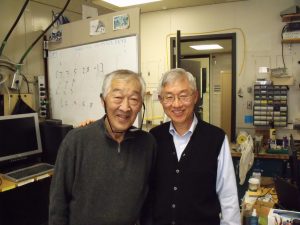As posted in UConn Today – September 25, 2020

UConn Health neuroscientists Duck O. Kim and Shigeyuki Kuwada passionately wanted to figure out the real story. Kuwada had made many contributions to science’s understanding of binaural (two-eared) hearing, beginning in the 1970s. Binaural hearing is essential to how we localize where a sound is coming from. Kuwada (or Shig, as his colleagues called him) and Kim, both professors in the School of Medicine, began collaborating in 2005 on how neural processing of amplitude modulation influences the way we recognize speech. They had a lot of experience studying individual neurons in the brain, and together with Laurel Carney at the University of Rochester, they came up with an ambitious plan: they would systematically probe how every single neuron in a specific part of the brain reacted to a certain sound when that sound was amplitude modulated, and when it was not. They studied isolated single-neuron responses of 105 neurons in the inferior colliculus (a part of the brainstem) and 30 neurons in the medial geniculate body (a part of the thalamus) of rabbits. The study took them two hours a day, every day, over a period of years to get the data they needed.
While they were writing up their results, Shig became ill with cancer. But still he persisted in the research. And after years of painstaking measurement, all three of the researchers were amazed at the results of their analysis: there was a hitherto unknown population of neurons that did the exact opposite of what the conventional wisdom predicted. Instead of getting excited when they heard certain amplitude modulated frequencies, they quieted down. The more the sound was amplitude modulated in a specific modulation frequency, the quieter they got.
It was particularly intriguing because the visual system of the brain has long been understood to operate in a similar way. One population of visual neurons (called the “ON” neurons) gets excited by certain visual stimuli while, at the same time, another population of neurons (called the “OFF” neurons) gets suppressed.
Last year, when Shig was dying, Kim made him a promise.
“In the final days of Shig, I indicated to him and his family that I will put my full effort toward having our joint research results published. I feel relieved now that it is accomplished,” Kim says. The new findings could be particularly helpful for people who have lost their ability to hear and understand spoken words. If they can be offered therapy with an implant that stimulates brain cells directly, it could try to match the natural behavior of the hearing brain.
Read more on “Hearing Speech Requires Quiet – In More Ways Than One“.